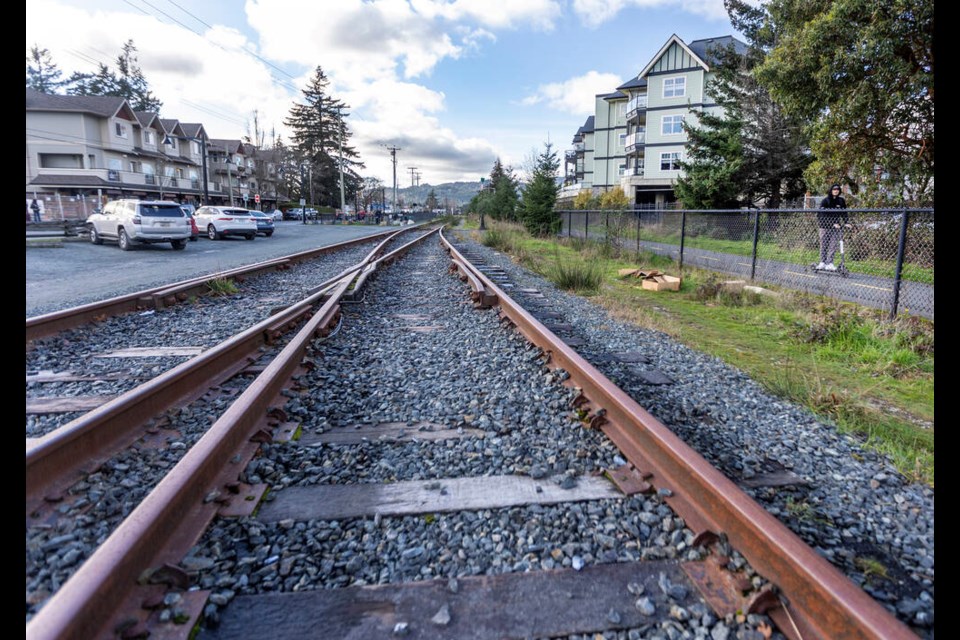The chief of the Cowichan Tribes says E&N lands in her nation’s territories are needed for housing, and she doesn’t want any rail services or recreational trails running through its reserves.
Chief Sulsulxumaat Cindy Daniels said the Tribes have told the Island Corridor Foundation they want to take back the railway corridor lands that run through their Koksilah and Somenos reserves. “It’s not there for recreation use, or hiking trails or an alternate route to Victoria. People keep throwing those ideas at us, but that was never our plan. It was stolen from us and we want our land back because the train is no longer running,” she said in a interview, noting homes are needed for the more than 700 people on the nation’s housing waitlist.
Daniels said she doesn’t see the possibility of reactivating passenger rail on the E&N after Snaw-Naw-As Nation took back right-of-way lands on its reserve and tore up the tracks last year.
A recent Cowichan Valley Regional District report said rail service would be “technically challenging and costly” if realignments had to be made for all five sections of rail that bisect reserves in the valley, and that decisions by the nations will decide whether rail or trail would still be feasible in the corridor.
The Island Rail Corridor stretches from Victoria to Courtenay, with a spur line from Parksville to Port Alberni.
In 1884, the Crown granted the right-of-way to the E&N Railway Company as part of negotiations to help bring the colony of British Columbia into the confederation of Canada.
Hul’qumi’num peoples in the Cowichan Valley call the railway grant the “Great Land Grab,” as it privatized about 800,000 hectares of land on eastern Vancouver Island without First Nations consent, including the vast majority of the core Hul’qumi’num territories.
Trains began running on the corridor from Esquimalt to Nanaimo in 1886, but passenger service was halted in 2011 due to deteriorating tracks caused by a lack of maintenance.
A review by engineering firm Stantec says restoring rail service between Victoria and Courtenay would likely cost $901 million, with annual operating costs of $32 million.
A trail built on the rail bed would cost between $55 million and $280 million, depending on how much soil remediation is involved, and a rail and trail option would cost more than $1 billion.
Since the 2000s, much of the corridor has been owned by the Island Corridor Foundation, which consists of five regional districts and 14 First Nations.
Following the return of land to the Snaw-Naw-As, nations that still have reserves bisected by a rail right-of-way include the Songhees, Esquimalt, Halalt and Snuneymuxw.
A short section of the railway bisecting Snuneymuxw lands is still used for transport of barged goods around Wellcox Yard in Nanaimo.
In the February report from the CVRD, which includes First Nations feedback on the future of the rail corridor, Halalt First Nation said the rail line bisecting its reserve located between Duncan and Chemainus has made it hard to reach cultural sites on the other side of the tracks.
But the nation, which has 213 registered members, said it wants to see fewer trucks on the highway and is interested in seeing what options are available for the corridor, the report said.
Any future rail operation would have to address safety issues of a train running through the reserve, it said.
The Penelakut and Stz’uminus nations did not present any opinions in the report on how the corridor should be used, with Stz’uminus — which has a reserve bisected by the railway corridor — saying it needed more time to consult with the community.
Foundation CEO Thomas Bevan said his organization will work with Cowichan Tribes on their direction, adding the foundation already has a clear process on how to revert right-of-way lands to First Nations.
However, Cowichan Tribes has yet to start the formal process with the Island Corridor Foundation for the return of the land, Bevan said.
Less than 10 of 289 kilometres of the E&N lands bisect reserves, so the vast majority of the corridor remains contiguous, Bevan said.
The Ministry of Transportation and Transit said it is committed to finding the “best use” for the Island Rail Corridor, which includes supporting Indigenous communities affected.
Talks at an Island Corridor Foundation roundtable this month showed that there has yet to be a unified vision for the future of the corridor, the ministry said in a statement, adding that discussions continue with federal, local and First Nations governments.
It also said that the deadline to use the $18-million grant meant for First Nations and regional districts to plan for the future of the E&N railway corridor has been extended to March 31, 2026.
The grant was supposed to expire at the end of 2024 and has already been extended once.
Transport Canada spokesperson Sau Sau Liu said the rail corridor falls under the jurisdiction of B.C.’s Ministry of Transportation and the federal government of Canada will not be commenting further due to ongoing legal proceedings.
Snaw-naw-as and Songhees nations both launched separate legal actions in 2024 against the federal government and the Island Corridor Foundation over contaminated land caused by a century of rail service.
— With files from Carla Wilson
>>> To comment on this article, write a letter to the editor: [email protected]



